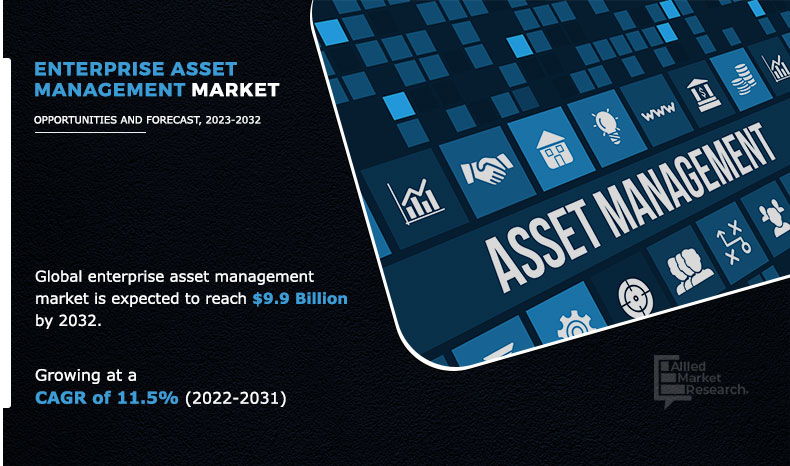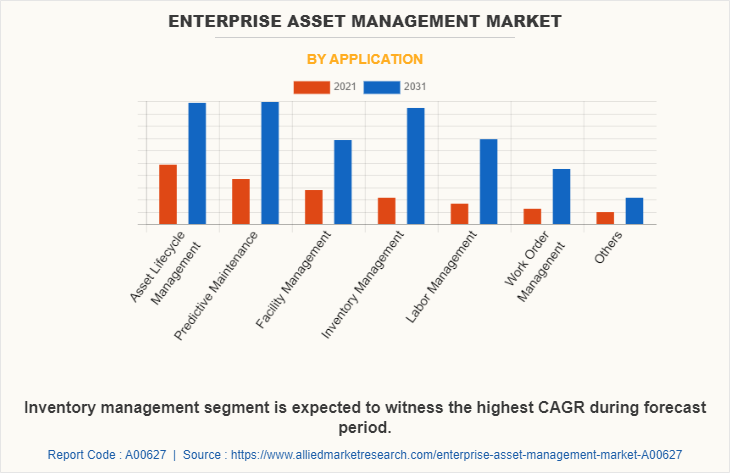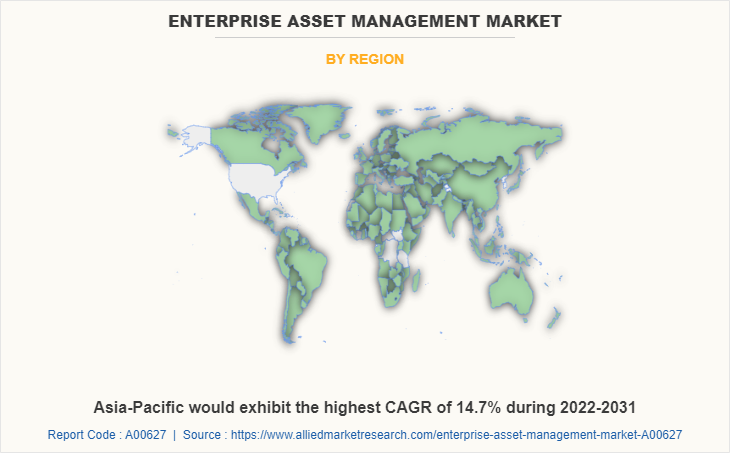Enterprise Asset Management Market Statistics, 2031
The global enterprise asset management market was valued at $3.4 billion in 2021, and is projected to reach $9.9 billion by 2031, growing at a CAGR of 11.5% from 2022 to 2031. Increase in need for enhancing the lifecycle performance of assets fuels the growth of the global EAM market. Furthermore, dependence on physical infrastructure, is highly responsible for driving the market. Advent of cloud deployment model and big data integration with EAM are likely to create business opportunities. However, high cost and lack of awareness hindered the market growth. Asia-Pacific and Middle East & Africa would provide several opportunities for the expansion of the enterprise asset management market, owing to rise in adoption rate.

Enterprise asset management (EAM) is a set of processes and tools that allow companies to track and manage their physical assets such as machines, equipment, buildings, and vehicles throughout their lifecycle from procurement to disposal. At its core, EAM is used to plan, optimize, execute, and track all maintenance activities with the associated priorities, skills, materials, tools, cost, and other information.
Segment Review
The global enterprise asset management market size is segmented into component, deployment model, enterprise size, application, industry vertical, and region. Depending on component, the market is bifurcated into solutions and services. By deployment model, it is classified into on-premise and cloud. On the basis of enterprise size, it is segregated into large enterprises and small- & medium-sized enterprises. According to application, it is classified into work order management, predictive maintenance, asset lifecycle management, inventory management, labor management, facility management, and others. By industry vertical, the market is fragmented into energy & utility, transportation & logistics, manufacturing, healthcare & life science, government & public sector, education, IT & telecommunications, and others. Region wise, the market is analyzed across North America, Europe, Asia-Pacific, and LAMEA.

According to application, the asset lifecycle management segment holds the largest enterprise asset management market share, since it helps to effectively plan, design, and seamlessly deliver complex asset projects into asset operations and maintenance. Furthermore, it saves time, reduce errors, and control progress & costs by managing asset planning and realization process end-to-end. However, the inventory management segment is expected to grow at the highest rate during the forecast period. This is attributed to the fact that an EAM can provide valuable insight into parts utilization and costs. This makes it easier to see actual spend on individual parts and improve part sourcing to reduce inventory costs. An EAM further offers capabilities like automated inventory control that streamlines the inventory process.

Region wise, the enterprise asset management market share was dominated by North America in 2020, and is expected to retain its position during the forecast period. The market in the region is witnessing a significant shift as a result of the introduction of additional and new technologies. Demand for EAM software has increased as the penetration of industrial Internet of Things (IIoT) has grown. IoT further helps with data monitoring and retrieval from remote sites. However, Asia-Pacific is expected to witness significant growth during the forecast period. This is attributed to increased need for strict regulatory compliance pertaining to asset management, increase in the number of EAM suppliers, and reduced government aid for EAM are all contributing to the region's market growth.
The key players that operate in the EAM market are ABB Ltd., AssetsWorks, LLC, CGI Group Inc., IFS, International Business Machine Corporation, Infor, Oracle Corporation, SAP SE, SSG Insights, and UpKeep Technologies, Inc.
COVID-19 Impact Analysis
The COVID-19 pandemic had a positive impact on the EAM market. This is attributed to the fact that enterprises suffered huge losses during the lockdown because of business closures, however, after reopening enterprises begun to focus on trimming costs, generating savings, and securing liquidity that would allow them to survive another wave of restrictions and a potential freeze on individual sectors of the economy. Therefore, EAM is of great importance in the time of corona virus, when companies are looking for savings to optimize processes, and increase the efficiency of the resources at their disposal. Successful digital transformation in this area translates into a real improvement in the company’s financial performance. Thus, the COVID-19 pandemic had a positive impact on the enterprise asset management market.
Top Impacting Factors
Increase Demand for Cloud-based EAM Solutions Among Enterprises
EAM systems are being used by a number of companies throughout the world to improve work productivity, streamline processes, boost company agility, and manage facilities. In addition, cloud-based enterprise asset management software and services are utilized to optimize critical corporate assets and acquire business analytics for decision-making. Moreover, these solutions allow businesses to save money on overheads. Furthermore, enterprise asset management systems that are cloud-based provide superior technical support and services, such as managed services with integrated debugging and performance monitoring tools. Moreover, it reduces extra expenditures needed to incur by the enterprises for asset management. Thus, increase in demand for cloud-based EAM solutions among enterprises is driving the growth of the enterprise asset management industry.
High Cost of Software and Lack of Awareness in Developing Economies
Essential business operations are supported by EAM software, and it is an investment that pays off. However, the installation and maintenance of this software incur high costs, which restrains its adoption among SMEs. Moreover, low awareness among enterprises in developing economies about EAM software acts as a key deterrent factor of the global enterprise asset management market. Hence, these companies are cost-sensitive, they follow traditional methods to manage their assets. Thus, high cost of software and lack of awareness in developing countries hinder the growth of the enterprise asset management industry.
Key Benefits for Stakeholders
- This report provides a quantitative analysis of the market segments, current trends, estimations, and dynamics of the enterprise asset management market forecast from 2022 to 2031 to identify the prevailing enterprise asset management market opportunities.
- The market research is offered along with information related to key drivers, restraints, and opportunities.
- The Porter's five forces analysis highlights the potency of buyers and suppliers to enable stakeholders make profit-oriented business decisions and strengthen their supplier–buyer network.
- In-depth analysis of the enterprise asset management market segmentation assists to determine the prevailing market opportunities.
- Major countries in each region are mapped according to their revenue contribution to the global market.
- Market player positioning facilitates benchmarking and provides a clear understanding of the present position of the market players.
- The report includes the analysis of the regional as well as global enterprise asset management market trends, key players, market segments, application areas, and enterprise asset management market growth strategies.
Enterprise Asset Management Market Report Highlights
| Aspects | Details |
| By Comonent |
|
| By Deployment Model |
|
| By Organization Size |
|
| By Application |
|
| By Industry Vertical |
|
| By Region |
|
| Key Market Players | IFS, Rfgen Software, Intelligent Process Solutions, Ibm Corporation, Infor, Oracle, Asset Infinity, Asset Panda, ABB, SAP SE |
Analyst Review
EAM capabilities are expanding to better meet and exceed the evolving needs of asset-intensive organizations. These next-gen solutions offer the visibility required to manage assets and operations within an organization. In addition to expanding the use of digital transformation, key functional areas include asset information; work order management; maintenance, repair, and operation materials; labor skills; service contracts; finance; and analytics. As EAM become increasingly intelligent and interconnected, thus, its role as an important repository for enterprise asset data that can be shared with adjacent systems is growing. Customer interest in leveraging EAM to provide greater insight into areas such as asset lifecycle management, asset performance management, and reliability-centered maintenance is driving innovation across industries.
The CXOs further added that the essential function of EAM is asset lifecycle management, which helps enterprises to move away from an asset tracking system that is kept on paper or spreadsheets and move this essential data into a centralized hub. It helps to plan and streamline asset tracking and management at every stage of an asset’s life. Furthermore, EAM software comes with built-in features to improve inventory and stock control procedures. In addition, it allows users to have a clear look at supply chain management at their company. It covers spare parts procurement, stock control, purchasing, estimating demand for materials, and making accurate inventory forecasts. Therefore, these factors are propelling the growth of the market. Some of the key players profiled in the report include ABB Ltd, AssetsWorks, CGI Group, IFS, IBM, Infor, Oracle, SAP SE, SSG Insights and UpKeep Technologies, Inc. These players have adopted various strategies to increase their market penetration and strengthen their position in the industry.
The Enterprise Asset Management Market is estimated to grow at a CAGR of 11.5% from 2022 to 2031.
The Enterprise Asset Management Market is projected to reach $9.9 billion by 2031.
Increase in use of IoT devices across almost all industrial verticals, integration of drone & AI-based asset management, and surge in need for cloud-based enterprise asset management system solutions are propelling the global enterprise asset management market growth.
The key players that operate in the enterprise asset management industry are ABB Ltd., AssetsWorks, LLC, CGI Group Inc., IFS, International Business Machine Corporation, Infor, Oracle Corporation, SAP SE, SSG Insights and UpKeep Technologies, Inc.
The key growth strategies of Enterprise Asset Management market players include product portfolio expansion, mergers & acquisitions, agreements, geographical expansion, and collaborations.
Loading Table Of Content...


